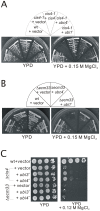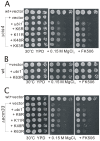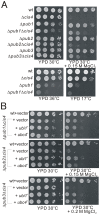E3 ubiquitin ligase Pub1 is implicated in endocytosis of a GPI-anchored protein Ecm33 in fission yeast
- PMID: 24454826
- PMCID: PMC3891804
- DOI: 10.1371/journal.pone.0085238
E3 ubiquitin ligase Pub1 is implicated in endocytosis of a GPI-anchored protein Ecm33 in fission yeast
Abstract
We previously identified three glycosylphosphatidylinositol (GPI)-anchored proteins including Ecm33, as multicopy suppressors of the phenotypes of a mutant allele of cis4(+) that encodes a zinc transporter in fission yeast. Here, we further identified two multicopy suppressor genes, ubi1 (+) and ubc4 (+), encoding ubiquitin-ribosomal fusion protein and ubiquitin conjugating enzyme E2, respectively. In addition, Ubi1 or Ubc4 overexpression failed to suppress the phenotypes of the double deletion of cis4 (+) and pub1 (+) gene, which encodes a HECT-type ubiquitin ligase E3. During exponential phase GFP-Ecm33 localized at the growing cell tips of the cell surface and the medial region in wild-type cells. Notably, during the post-exponential and stationary phase, GFP-Ecm33 in wild-type cells was internalized and mostly localized to the Golgi/endosomes, but it was still stably localized at the cell surface in Δpub1 cells. The Δpub1 cells showed osomoremedial phenotypes to various drugs indicating their defects in cell wall integrity. Altogether, our findings reveal a novel role for Pub1 in endocytosis of Ecm33 and regulation of cell wall integrity in fission yeast.
Conflict of interest statement
Figures






Similar articles
-
Studies on the roles of clathrin-mediated membrane trafficking and zinc transporter Cis4 in the transport of GPI-anchored proteins in fission yeast.PLoS One. 2012;7(7):e41946. doi: 10.1371/journal.pone.0041946. Epub 2012 Jul 25. PLoS One. 2012. PMID: 22848669 Free PMC article.
-
The novel HECT-type ubiquitin-protein ligase Pub2p shares partially overlapping function with Pub1p in Schizosaccharomyces pombe.J Cell Sci. 2002 May 1;115(Pt 9):1847-57. doi: 10.1242/jcs.115.9.1847. J Cell Sci. 2002. PMID: 11956316
-
Loss of Apm1, the micro1 subunit of the clathrin-associated adaptor-protein-1 complex, causes distinct phenotypes and synthetic lethality with calcineurin deletion in fission yeast.Mol Biol Cell. 2004 Jun;15(6):2920-31. doi: 10.1091/mbc.e03-09-0659. Epub 2004 Mar 26. Mol Biol Cell. 2004. PMID: 15047861 Free PMC article.
-
[Cell surface protein Ecm33 is involved in negative feedback regulation of MAP kinase signalling and development of the in vivo real-time monitoring of MAP kinase signalling].Yakugaku Zasshi. 2011;131(8):1195-200. doi: 10.1248/yakushi.131.1195. Yakugaku Zasshi. 2011. PMID: 21804323 Review. Japanese.
-
UBA domain containing proteins in fission yeast.Int J Biochem Cell Biol. 2003 May;35(5):629-36. doi: 10.1016/s1357-2725(02)00393-x. Int J Biochem Cell Biol. 2003. PMID: 12672455 Review.
Cited by
-
Cell Lysis in S. pombe ura4 Mutants Is Suppressed by Loss of Functional Pub1, Which Regulates the Uracil Transporter Fur4.PLoS One. 2015 Nov 4;10(11):e0141796. doi: 10.1371/journal.pone.0141796. eCollection 2015. PLoS One. 2015. PMID: 26536126 Free PMC article.
-
The exocyst subunit Sec3 is regulated by a protein quality control pathway.J Biol Chem. 2017 Sep 15;292(37):15240-15253. doi: 10.1074/jbc.M117.789867. Epub 2017 Aug 1. J Biol Chem. 2017. PMID: 28765280 Free PMC article.
-
The Ubiquitin Ligase CHIP Integrates Proteostasis and Aging by Regulation of Insulin Receptor Turnover.Cell. 2017 Apr 20;169(3):470-482.e13. doi: 10.1016/j.cell.2017.04.003. Cell. 2017. PMID: 28431247 Free PMC article.
References
Publication types
MeSH terms
Substances
LinkOut - more resources
Full Text Sources
Other Literature Sources
Molecular Biology Databases
Research Materials

